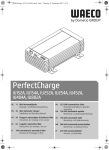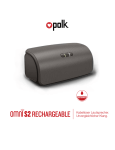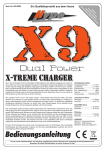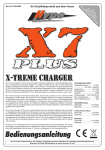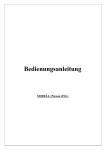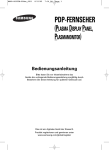Download Bedienungsanleitung für NiMH Fernsteuerungsakkus
Transcript
Bedienungsanleitung für NiMH Fernsteuerungsakkus Operating instructions for NiMH batteries used in radio control systems Mode d’emploi pour accus CdMH pour ensembles de radiocommande Fernsteueranlagen sind hoch entwickelte Elektronikgeräte und müssen deshalb auch mit entsprechenden Stromquellen betrieben werden. Batterien oder einzelne Zellen sind hierfür weniger geeignet, da es durch Vibrationen zu Stromunterbrechungen kommen kann. Weiterhin ist bei Verwendung von Einzelzellen nicht sichergestellt, daß die Kapazität der einzelnen Zellen etwa gleich ist. Es kann daher vorkommen, daß einzelne Zellen tiefentladen werden, und ihre Polarität wechseln. Aus Sicherheitsgründen empfehlen wir Ihnen deshalb für die Stromversorgung des Senders und Empfängers stets fertig konfektionierte Akkupacks aus dem robbe Sortiment zu verwenden. Hier finden Sie eine breite Auswahl an Akkus verschiedener Zellenzahlen und Kapazitäten. Moderne Nickel-Metall-Hydrid Akkus (NiMH), sind an sich eine recht pflegeleichte und zuverlässige Stromquelle. Dennoch sollten einige wichtige Grundsätze im Umgang mit solchen Akkus beachtet werden. Sie werden es mit langer Lebensdauer und einem Höchstmaß an verfügbarer Energie danken. Laden von Akkus Formierung: Ein neuer oder über einen langen Zeitraum nicht benutzter Akku sollte vor dem ersten Einsatz formiert werden. Auch ein Akku der tiefentladen wurde, bei dem einige Zellen dadurch umgepolt sind, muss zunächst wieder formiert werden. Dabei sollte er für 14 -16 Stunden mit einem Strom, der 10% (1/10) der Nennkapazität entspricht, geladen werden. Beispiel: NiMH-Akku 4,8 Volt / 800 mAh, Ladestrom 1/10 = 80 mA. Geeignete Ladegeräte Zum Normalladen reicht ein einfaches Universalladegerät, welches einen konstanten Gleichstrom in der erforderlichen Größe zur Verfügung stellt (z.B. Robbe Lader 5 oder Lader 6). Komfortabler ist der MTC 52, ein Universallader mit internem Timer, der nach 14 Stunden die Ladung automatisch ab- und auf Erhaltungsladung umschaltet. Beide Ladegeräte verhindern aber nicht den bei Sender- und Empfängerakkus häufig vorkommendem „Memory“ Effekt. Was passiert? Üblicherweise werden Akkus nie ganz entladen, man lädt sie aber sicherheitshalber wieder ganz voll. Ein Akku merkt sich das und gibt den Teil seiner Kapazität, die üblicherweise entnommen wird, bereitwillig ab. Benötigt man aber einmal mehr Kapazität, will also die gesamte Energie entnehmen, ist der Akku dazu nicht mehr in der Lage. Bekannt ist dieser Effekt bei Videokameras. Der Akku wird immer gut geladen, aber wenn es darauf ankommt ist er leer. Dies kann man umgehen indem man nach ein paar unvollständigen Zyklen die Akkus auf Entladeschlußspannung (1 Volt / Zelle) entlädt und anschließend wieder lädt. Dazu bieten wir einfache Entladegeräte an, die man vor einen Universallader schaltet. Zunächst wird der Akku entladen, und das Entladegerät schaltet dann auf Laden um. Die erheblich bessere Variante ist das Laden mit dem neuen Reflex-Lader von robbe. Dabei wird der Akku während dem Laden automatisch mit kurzen hohen Stromimpulsen entladen. Danach schaltet dieses Gerät bei vollem Akku automatisch ab und hält mit einem Impulserhaltungsladestrom den Akku fit. Hinweis: Ein Entladen des Akkus vor jedem Laden altert den NiMH-Akku unnötig. Deshalb empfehlen wir das Reflexladeverfahren für optimale Akkuschonung und Nutzung. Entladeschlußspannung, Tiefentladung Die zulässige Entladeschlußspannung beträgt, gemessen unter Last, ca. 1Volt pro Zelle (z. B. 7 zelliger Akku = 7 V). Bei weiterer Entladung tritt eine Tiefentladung ein. Dadurch kann es zur Umpolung einer oder mehrerer Zellen kommen. Umgepolte Zellen wechseln ihre Polarität. Am Pluspol liegt Minuspotential, am Minuspol liegt Pluspotential an (bei geringer Belastung mit Voltmeter prüfen). Zellendefekte können, wenn überhaupt, nur durch eine sofortige 14 -16 Stunden Normalladung verhindert werden. Vermeiden Sie Tiefentladungen bei NiMH-Akkus, Tiefentladungen können zu irreparablen Defekten der Zelle, und im Extremfall zu einem Ansprechen des Sicherheitsventils und damit Abblasen von Gas und Elektrolyt führen. Ladeverfahren Beim Laden von NiMH-Akkus unterscheidet man zwischen Normal - und Schnelladung. Für die Größe der Lade- und Entladeströme hat sich der Begriff der Laderate (C) eingebürgert. Beispiel Ein Akku mit einer Kapazität von 600 mAh wird mit einer Laderate von 1 C geladen, wenn ein Strom von 600 mA fließt. Normalladung Bis zu einer Laderate von 0,1 - 0,2 C spricht man von einer Normalladung. Eine beschleunigte Ladung liegt vor, wenn ein Ladestrom in Höhe von 0,3 - 0,5 C fließt. Da man in den Akku immer etwas mehr einladen muß als man entnehmen kann, ist die Ladezeit bei Normalladung mit 0,1 C nicht 10 Stunden, sondern 14-16 Stunden. Das heißt bei Normalladung beträgt der Ladefaktor 1,5. Längeres Laden dieser Art schadet dem Akku und sollte daher vermieden werden, da die zugeführte elektrische Energie nicht mehr gespeichert wird, sondern chemische Prozesse und Wärmeentwicklung auslöst, die die Lebensdauer der Akkus verringern. Bei größeren Laderaten als 0,1 C, muß die Ladung überwacht und rechtzeitig abgeschaltet werden, sobald der Akku voll aufgeladen ist. Ein starkes Überladen schädigt den Akku auf Dauer, führt zu geringerer Spannung, Kapazität und kurzer Lebensdauer. Schnelladung Fast alle NiMH-Akkus sind schnelladefähig. Das heißt, sie können mit einer Laderate von maximal 1C geladen werden, die Ladezeit beträgt dann 1,1 bis 1,2 Stunden. Radio control systems are highly developed electronic equipment which must be operated with the correct type of power source. Dry batteries and separate cells are a poor choice, as vibration can affect the inter-cell connections and interrupt the power supply. A further drawback of separate cells is that you cannot be sure that the capacity of the individual cells is identical, and the result can be that individual cells become deep-discharged and reverse their polarity. In the interests of safety we therefore recommend that you always use factory-prepared battery packs from the robbe range to power your transmitter and receiver. Our range includes a wide selection of batteries differing in cell count and capacity. Modern Nickel-Metal-Hydride (NiMH) batteries are inherently reliable power sources which are extremely easy to maintain. However, there are a number of important basic rules which you should always observe when handling these packs. They will reward you for your trouble by working reliably over a long period, and giving you a constantly high level of available energy. Charging batteries Balancing: A new pack, or one which has not been used for a long period, should always be “balanced”, i.e. all its cells brought to the same state of charge, before being used for the first time. The same applies to any battery which has been deep-discharged, and in which one or more cells exhibit reverse polarity. This is done by giving the pack a long, slow charge for 14 - 16 hours at a current which corresponds to 10% (1/10) of its nominal capacity. Example: 4.8 V/800 mAh NiMH pack: charge current at 1/10 = 80 mA Battery chargers Simple, general-purpose battery chargers are quite adequate for normal charging, provided that they deliver a constant current of the required magnitude. Good examples are the Robbe Lader 5 and Lader 6. A more convenient solution is the MTC 52, an allpurpose charger with an internal timer which automatically switches off the charge current after 14 hours; it then switches to a low trickle current. Neither of these types of charger is able to prevent the “Memory” effect which can be a problem with transmitter and receiver batteries. What is the memory effect? RC system batteries are never completely discharged in normal use, but to be on the safe side we still give them a full charge before the next session. Batteries “remember” this, and change their behaviour: they are still able to provide the proportion of their full capacity which is normally extracted from them, but if they are required to give up their full capacity one day, they are no longer capable of doing it. This effect is likely to be familiar to any video camera user. You keep the battery well charged, but when you really need it, the pack is flat. You can circumvent this problem by breaking the memory cycle now and then, i.e. by discharging the battery to its final discharge voltage (1 Volt per cell), and then giving it a full charge again. We can supply simple dischargers for this purpose, designed for use in conjunction with a standard charger. The discharger discharges the pack, then the charger connected to it recharges it completely. An even better solution is to charge the pack using the new robbe Reflex Charger. This unit automatically discharges the battery during the charge process by means of brief but high pulses of current. The Reflex Charger automatically switches off when the pack is fully charged, and keeps it up to the mark with a pulsed trickle charge. Note: it is not good practice to discharge NiMH packs before each charge, as this causes unnecessary ageing effects. For this reason we particularly recommend the reflex charge process if you wish to maintain your batteries in top condition. Final discharge voltage, deep-discharging The permissible final discharge voltage is around 1 Volt per cell measured under load (e.g. 7-cell battery: 7 V). If the pack is discharged beyond this point, the cells become deepdischarged, and this can cause one or more cells to reverse their polarity. This means that the affected cells exhibit a negative potential at the positive terminal, and a positive potential at the negative terminal; you can check this using a Voltmeter set to a low load. Polarity reversal causes permanent cell damage unless corrected without delay. The problem can only be remedied by giving the pack an immediate slow charge lasting 14 - 16 hours. It is very important to avoid deep-discharging NiMH packs, as this can cause irreparable cell damage. In extreme cases the cells’ safety valve may be triggered, leading to a permanent loss of gas and electrolyte. Charging procedures We have to differentiate between slow and rapid charging when dealing with NiMH batteries. It is standard practice to use the charge rate (C) to define the magnitude of charge and discharge currents. Example: A battery with a capacity of 600 mAh is charged at a rate of 1 C by setting a charge current of 600 mA. Slow charging Slow or normal charging is the term used for charge rates of 0.1 - 0.2 C. Accelerated charging means that the charge current is 0.3 - 0.5 C. Battery charging is not 100% efficient, so it is always necessary to charge into the pack slightly more energy than can be extracted from it. This means that the standard charge period for a slow charge at 0.1 C is not 10 hours, as you might expect, but 14 - 16 hours, i.e. a charge factor of 1.5 is applied for slow charging. Charging NiMH packs at these rates for a longer period can damage the battery, as the excess electrical energy fed into the pack cannot be stored. Instead the energy triggers chemical processes and causes excessive heat which reduce the useful life of the battery. Don’t overcharge NiMH batteries! At charge rates higher than 0.1 C it is essential to monitor the charge process and switch it off in good time, i.e. as soon as the battery is fully charged. Serious over-charging will damage any battery permanently, resulting in lower voltage, reduced capacity and short life. Rapid charging Almost all NiMH batteries are capable of being rapid-charged. Les ensembles de radiocommande sont des appareils électroniques de haut niveau qui doivent donc également être alimentés par des sources appropriées. Les batteries ou les éléments autonomes ne sont de ce fait guère appropriés étant donné qu’ils sont susceptibles de provoquer des interruptions d’alimentation à cause des vibrations. Par ailleurs, avec l’emploi d’éléments autonomes, il n’est pas garanti que la capacité de chacun d’entre eux soit adaptée ou égale. Il peut donc se produire que des éléments autonomes subissent une décharge absolue et inversent leur polarité. Pour des raisons de sécurité nous recommandons donc d’utiliser pour l’alimentation de vos émetteurs et récepteurs des packs d’accus assemblés et câblés proposés dans la gamme robbe. Robbe vous propose un assortiment d’accus pourvus d’un nombre différent d’éléments de capacité variable. Les accus hybrides nickel-métal (NiMH) constituent en soi une source d’alimentation très facile à entretenir et très efficace. Toutefois la manipulation de ces accus exige le respect d’un certain nombre de principes importants. Le respect de ceux-ci vous assure leur longévité et l’assurance d’une alimentation toujours disponible. Charge des accus Homogénéisation : un accu neuf ou stocké depuis un certain temps doit être homogénéisé avant sa première mise en service. C’est le cas également pour un accu ayant subi une décharge totale dans lequel un certain nombre d’élément risque d’avoir changé de polarité et qu’il faut donc d’abord homogénéiser. Pour ce faire, les charger d’abord pendant environ 24 heures avec un courant représentant 10 % de leur capacité nominale (1/ 10e). Exemple: accu NiMH de 4,8 volts / 800 mAh, 1/10e du courant de charge = 80 mA. Chargeurs appropriés Pour la charge normale, il suffit d’un chargeur universel normal qui fournisse un courant de charge stabilisé constant de la grandeur exigée (par ex. chargeur robbe Lader 5 ou Lader 6). Le chargeur universel MTC 52 avec minuterie interne est plus convivial étant donné qu’il assure automatiquement la commutation en fin de charge après 14 heures et passe en charge de maintien. Toutefois les deux types de chargeurs cités ci-dessus n’empêchent pas ce qui peut arriver souvent à des accus d’émission ou de réception c’est-à-dire de devenir “paresseux” ou de présenter un effet de “mémoire”. Que se passe-t-il ? Généralement, la décharge des accus n’est pas complète, on les recharge toutefois pour plus de sécurité. Cet accu le mémorise et redonne ainsi une partie de sa capacité, celle qu’on lui demande habituellement. S’il arrive toutefois que la capacité exigée soit supérieure, c’est-à-dire qu’on exige de lui l’intégralité de sa capacité, à ce moment-là, cet accu n’est plus en mesure de la fournie. Cette effet est connu sur les caméras vidéo. L’accu est toujours parfaitement chargé mais lorsqu’on exige un peu plus de lui, il est incapable de fournir la demande. Il est possible de contourner cet effet en déchargeant les accus à une tension de décharge (1 volt / élément) après un certain nombre de cycles incomplets avant de les recharger ensuite. Pour ce faire, nous proposons des appareils de décharge à intercaler en amont du chargeur universel. L’accu est donc d’abord déchargé avec que le déchargeur commute sur le chargeur. Il existe toutefois une variante plus avantageuse représentée par le nouveau chargeur reflex de robbe (Reflex-Lader). Avec cet appareil, pendant la charge, l’accu est d’abord déchargé par impulsions importantes automatiquement. Cet appareil commute ensuite en charge automatique et charge intégralement l’accu avant de passer en charge d’appoint afin de préserver dans l’accu la capacité optimale par impulsions de maintien de la charge jusqu’à la prochaine mise en œuvre. À noter: une décharge des accus NiMH avant chaque charge les vieillit prématurément et inutilement. Voilà pourquoi nous recommandons la charge par chargeur reflex afin de préserver au mieux les accus et de disposer en permanence de leur capacité optimale. Tension de décharge, décharge totale La tension de décharge autorisée mesurée sous charge est d’approx. 1 volt par élément (par exemple, accu de 7 éléments = 7 V). Lorsque la décharge est plus prononcée, intervient la décharge intégrale. À ce moment-là il peut se produire qu’un ou plusieurs éléments inversent leur polarité. Sur ces éléments, le plus devient le moins et le pôle négatif le plus ( lorsque la charge est minime, contrôler avec un voltmètre). Il est encore toutefois possible de corriger ces défectuosités par une charge immédiate de 14 à 16 heures plus longue qu’une charge habituelle. Éviter les décharges prononcées sur des accus NiMH, en effet, elles sont susceptibles de provoquer des dégâts irréparables sur les éléments et, dans le pire des cas, un déclenchement de la valve de sécurité et le dégagement de gaz et le d’électrolyte. Procédure de charge Pour la charge des accus NiMH on distingue entre charge normale et charge rapide. Pour la grandeur des courants de charge et de décharge. c’est la notion (C) qui s’est imposée pour les chargeurs. Exemple: un accu d’une capacité de 600 mAh est chargé avec 1 C, lorsqu’il fournit un courant de 600 mA. Charge normale Avec un taux de charge jusqu’à 0,1 à 0,2 C on parle de charge normale. Une charge est rapide lorsque le courant de charge délivré est de 0,3 à 0,5 C. Étant donné qu’il faut toujours charger un accu plus qu’il est en mesure de redonner, la durée de la charge normale avec 0,1 C n’est pas de 10 mais de 14 à 16 heures. C’est-à-dire qu’en charge normale, le facteur de charge est de 1,5. Des charge prolongées de ce type ne sont pas dommageables, il faut toutefois les éviter étant donné que l’excédent d’énergie fourni n’est plus emmagasiné mais qu’il déclenche des processus chimiques qui réduisent la durée de vie des accus. Avec des taux de charge supérieurs à 0,1 C, il faut que la charge soit surveillée et interrompue à temps, dès que l’accu est totalement chargé. Une surcharge excessive nuit à l’accu à long terme, en réduit la tension, la capacité et la durée de vie. Bedienungsanleitung für NiMH Fernsteuerungsakkus Operating instructions for NiMH batteries used in radio control systems Mode d’emploi pour accus CdMH pour ensembles de radiocommande Beispiel Ein Akku mit einer Kapazität von 1500 mAh wird mit einer Laderate von 1 C geladen, wenn ein Strom von 1,5 A fließt. Sender- und Empfängerakkus sollten jedoch nicht dauernd schnellgeladen werden. Gelegentliches Schnelladen schadet nicht, allerdings wird man nach einer Schnelladung immer etwas weniger Akkukapazität besitzen als bei einer Normalladung. Der Grund liegt in der Erwärmung der Zellen. Eine Schnelladung muß mit einem entsprechenden Ladegerät durchgeführt werden, um den Ladestrom automatisch abzuschalten, wenn der Akku voll ist. Hier ist die bekannteste Methode das Delta-Peak Ladeverfahren, welches den Spannungsanstieg im Akku mißt und somit feststellt wann der Akku voll ist. Nicht alle Delta-Peak Automatik - Abschaltverfahren sind für NiMH - Akkus geeignet, die meisten sind für NC-Akkus ausgelegt und schalten zu spät ab, d.h. der NiMH - Akku wird generell überladen, dadurch zu heiß und nimmt dauerhaft Schaden. Die Delta-Peak Abschalt-Empfindlichkeit der Geräte soll nicht schlechter als (-Delta U) 10 mVolt / Zelle sein. Beachten Sie bitte, daß die der Schnelladung folgende Erhaltungsladung den Akku nicht überlädt. Geladenen Akku bald vom Ladegerät trennen. Achten Sie auf die Angaben des Ladegeräteherstellers ob das Gerät für NiMH-Akkus geeignet ist. Alle robbe Schnelladegeräte mit der Digitalen - Delta - Peak Automatikabschaltung sind zum Laden von NiMH-Akkus geeignet. Sie können selbst einen einfachen Test durchführen. Ein mit einem Ladestrom von 1C geladener NiMH-Akku sollte nach Abschalten der Automatik nicht wärmer sein als ca. 40° C. Ladegeräte die den Akku deutlich stärker erwärmen sind nicht geeignet und führen zu einer dauerhaften Schädigung. Achtung: Laden im Sender: Maximal zulässigen Ladestrom der Senderladebuchse beachten. Bei Verwendung von Automatikladern (Reflex-Lader, Akkufit etc.) muß die Schutzdiode im Sender überbrückt werden. Allgemeines Ein Akku erreicht nur dann seine volle Kapazität beim Aufladen, wenn er in etwa Zimmertemperatur (20°C) besitzt. Eine warme Zelle nimmt weniger Ladung auf und kann dementsprechend auch weniger abgeben. Lebensdauer NiMH-Akkus besitzen je nach Anwendung und Verwendung des Ladeverfahrens eine Lebensdauer von ca. 500 bis maximal 1000 Zyklen. Danach ist der Akku verbraucht und muß entsorgt werden. Selbstentladung NiMH - Akkus verlieren pro Tag ca. 2-3% ihrer Ladung. Nach ca. 50 Tagen hat sich, je nach Lager-Temperatur, ein voller Akku komplett entladen. Vor Gebrauch müssen die Akkus daher gegebenenfalls nachgeladen werden. Lagerung: Soll ein NiMH-Akku auf absehbare Zeit nicht benutzt werden, so ist er kühl und trocken zu lagern (-20 bis + 30°C), dabei ist es egal ob der Akku auf Entladeschlußspannung entladen wird oder noch vollgeladen ist. Einziger Vorteil bei der Entladung vor dem Einlagern ist, daß sofort nach den ersten Laden nahezu die volle Spannung und Kapazität zur Verfügung steht. Wurde der Akku vorher nicht entladen, so ergibt die erste Ladung nur ca. 90 – 95 % der Spannungslage und Kapazität und erst nach 2-3 Ladezyklen ist die volle Leistung wieder da. Sicherheitshinweise Beim Umgang mit NiMH-Zellen müssen einige Vorsichtsmaßnahmen unbedingt beachtet werden, um Personen- und Sachschäden zu vermeiden. Beim Einsatz dieser Akkus übernehmen Sie die Verantwortung dafür. - - NiMH-Zellen dürfen niemals mit offenem Feuer in Berührung kommen, es besteht Explosionsgefahr ab ca. 60° C. NiMH-Zellen niemals gewaltsam öffnen, es besteht Verätzungsgefahr. NiMH-Zellen niemals kurzschließen, es besteht Verbrennungs- und Explosionsgefahr. Ausgetretenes Elektrolyt niemals mit der Haut oder den Augen in Berührung bringen. Falls versehentlich doch geschehen, sofort mit reichlich Wasser spülen und einen Arzt aufsuchen. Zellen oder Akkus nicht in den Mund nehmen - giftig. Niemals mit dem Lötkolben auf dem Zellengehäuse löten: Isolationsschäden, Druckanstieg innerhalb der Zelle, Verkleben des Sicherheitsventils. Ein geladener Akku ist kein Kinderspielzeug. Akkus sollten Kindern unzugänglich aufbewahrt werden. Entsorgung Werfen Sie Batterien und Akkus auf keinen Fall in den Hausmüll. Um die Umwelt zu schützen, geben Sie defekte oder verbrauchte Akkus nur entladen zu den entsprechenden Sammelstellen. Dies sind alle Verkaufsstellen für Batterien und Akkus, oder kommunale Müllsammelstellen. Um Kurzschlüsse zu vermeiden, kleben Sie bitte eventuell blanke Kontakte mit Klebestreifen ab. Die Kosten für die Rückführung des Akkus und dessen Entsorgung sind schon mit dem Kaufpreis abgedeckt. Alle Stellen sind verpflichtet Akkus anzunehmen, gleich ob Sie sie dort gekauft haben oder nicht. Die Akkus werden wieder aufgearbeitet. Dadurch gelangt das Material wieder in den Produktionskreislauf. Helfen Sie mit, die Umwelt zu schützen und zu bewahren! Irrtum und technische Änderungen vorbehalten, für Druckfehler wird keine Haftung übernommen. Kopie oder Nachdruck, auch auszugsweise, nur mit schriftlicher Genehmigung der robbe Modellsport GmbH & Co. KG robbe-Form 40-4616 BAJJ This means that they can be charged at a current of up to 1 C, corresponding to a charge period of 1.1 to 1.2 hours. Example: A battery with a capacity of 1500 mAh is charged at a rate of 1 C by setting a charge current of 1.5 A. Please note that transmitter and receiver batteries should not be rapid-charged as standard practice. Giving the packs an occasional rapid charge does no harm, but you should be aware that an accelerated charge will always leave the battery with less available capacity than after a slow charge; this is due to the higher temperature which develops in the cells. If you wish to rapid-charge an NiMH pack it is essential to use a suitable battery charger, i.e. one which switches off the charge current automatically when the battery is full. The most widely used method of charge termination is the Delta Peak process, in which the rise in the pack’s voltage is monitored in order to determine when the battery is full. Not all automatic Delta Peak chargers are suitable for NiMH batteries. Most of them are designed for NC batteries and tend to switch off too late. Using this type of unit overcharges the NiMH pack, which overheats and sustains permanent damage. The Delta Peak termination sensitivity of the charger should be no lower than 10 mVolt / cell (Delta U). Please ensure that the trickle current which many chargers supply after the rapid-charge process is not sufficient to overcharge the battery. It is always better to disconnect the battery from the charger early rather than late. Read the charger manufacturer’s instructions to establish whether the charger is suitable for use with NiMH batteries. All robbe rapid chargers which feature automatic Delta Peak charge termination are suitable for use with NiMH batteries. You can carry out your own simple test as follows: charge a NiMH battery at 1 C, and measure the temperature of the cells when the automatic circuit switches off the charge current; the temperature should be no higher than 40°C. If your charger allows the pack to become significantly hotter than this, it is not suitable, and will cause permanent damage to the batteries. Caution: charging internal transmitter batteries Transmitter charge sockets cannot accept very high currents; keep within the stated maximum permissible current for your transmitter. If you wish to use an automatic charger (Reflex Charger, Akkufit etc.) the protective diode in the transmitter must be by-passed. General information A battery can only achieve full capacity on charge if its temperature is approximately 20°C (room temperature). Warm cells have reduced capacity to accept charge, and are therefore unable to make their full capacity available to you. Useful life NiMH batteries can be expected to last for about 500 to a maximum of 1000 cycles, varying according to usage and charge process. The battery should then be considered exhausted, and should be disposed of. Self-discharge NiMH batteries lose about 2 - 3% of their charge per day, so after about 50 days - depending on storage temperature - a fully charged pack is completely flat. This simply means that the batteries should always be recharged before use. Storage If you do not intend using a particular NiMH battery for the foreseeable future, store it in cool, dry conditions (-20 to +30°C); it does not matter whether the pack is discharged to final discharge voltage or is still full. The sole advantage of discharging before storage is that virtually its full voltage and capacity will be available immediately after the first full charge. If the pack is not discharged beforehand, only about 90 - 95% of its voltage and capacity will be available after the first charge; full performance will be restored after 2 or 3 charge cycles. Safety notes There are a number of safety measures which must always be observed when you are handling NiMH cells in order to avoid personal injury and damage to property. You assume full responsibility for safety when you purchase and use these batteries. - - - NiMH cells must never come into contact with open flames, as they may explode if the temperature reaches about 60°C. Never forcibly open NiMH cells, as the contents are corrosive. Never short-circuit the terminals of NiMH cells: fire and explosion hazard. If electrolyte escapes from the cells, do not allow it to contact your skin or eyes. If this should happen accidentally, rinse the area immediately with plenty of water and seek medical attention. Do not place cells or batteries in your mouth - they are toxic. Never apply a hot soldering iron directly to the case of the cell: you can easily damage the insulation, cause a pressure rise inside the cell, and damage the seal of the safety valve. Charged batteries are not playthings. Store batteries well out of the reach of children. Disposal Do not dispose of batteries and battery cells in the ordinary household rubbish. To protect the environment, discharge exhausted or faulty batteries completely, then take them to the appropriate collection point for toxic materials. These include all sales points for dry batteries and battery packs, and local authority waste disposal centres. To avoid short-circuits, insulate any bare contacts with adhesive tape. The cost of returning and disposing of the battery is included in the purchase price of the pack, and all retail outlets are obliged by law to accept returned batteries, whether you bought them there or not. Packs can then be reprocessed, and the materials returned to the production cycle. Please play your part in protecting and maintaining the environment. Errors and omissions excepted. We accept no liability for printing errors. No part of this document may be copied or reproduced by any means without the prior written authorisation of robbe Modellsport GmbH & Co. KG. Charge rapide Pratiquement tous les accus NiMH sont susceptibles de subir une charge rapide. C’est-à-dire qu’ils peuvent être chargés avec un taux de charge de 1C au maximum, la durée de la charge étant alors limitée à 1,1 à 1,2 heures. Exemple: Un accu d’une capacité de 1500 mAh est chargé avec un taux de charge de 1 C lorsque le courant de charge est de 1,5 A. Il ne fout toutefois jamais charger systématiquement en charge rapide les accus de réception et d’émission. Une charge rapide de temps en temps n’est pas dommageable, cependant, après chaque charge rapide on disposera de moins de capacité par rapport à une charge normale. L’origine de cette nuance se trouve dans l’échauffement des éléments. Une charge rapide doit être réalisée avec un appareil approprié qui commute automatiquement en fin de charge, lorsque l’accu est plein. Dans ce domaine c’est la commutation de fin de charge Delta-Peak qui est la plus connue et la plus efficace dans la mesure ou elle analyse l’évolution de la tension dans l’accu et est en mesure d’apprécier lorsque la charge est achevée. Toutes les procédures automatiques de fin de charge DeltaPeak ne sont pas appropriées pour les accus NiMH, la plupart sont conçues pour les accus Cd-Ni et la charge est interrompue trop tard, c’est-à-dire que l’accu NiMH est généralement surchargé, s’échauffe et subit des dommages à long terme. La sensibilité de commutation en fin de charge Delta-Peak des appareils ne doit pas être inférieure à (-Delta U) 10 mvolts / élément. Veiller à ce que la charge de maintien consécutive à la charge rapide ne surcharge pas l’accu. Retirer les accu chargés le plus rapidement possible du chargeur. Tenir compte des indications fournies par le fabricant du chargeur précisant si l’appareil est conçu pour la charge des accus NiMH. Tous les chargeurs rapides robbe à commutation de fin de charge Delta - Peak numérique sont appropriés à la charge d’accus NiMH. Vous pouvez vous-même réaliser un test simple : un accu NiMH chargé avec un courant de charge de 1C ne doit pas, après l’arrêt automatique en fin de charge, dépasser une température d’approx. 40° C. Les chargeurs qui provoquent un échauffement nettement supérieur de l’accu ne sont pas conçus pour sa charge et risquent de l’endommager définitivement. Attention: charge dans l’émetteur : tenir compte du courant de charge maximal indiqué pour la douille de charge. Lorsque vous employez un chargeur automatique (Chargeur Reflex-Lader, Akkufit, etc.) il faut shunter la diode de protection dans l’émetteur. Généralités Un accu n’atteint sa pleine capacité de charge que lorsque sa température coïncide avec la température ambiante, soit 20°C. Un élément échauffé prend moins de charge et en redonne donc moins. Durée de vie Les accus NiMH, disposent d’une durée de vie d’approx. 500 à 1000 cycles au maximum en relation avec la procédure de charge utilisée. Ensuite l’accu est usé et doit être mis au rebut. Autodécharge Les accus NiMH perdent, par jour, environ 2 à 3% de leur charge. Après approx, 50 jours un accu plein s’est entièrement vidé en fonction de sa température de stockage. Avant de les utiliser, il faut donc systématiquement les accus. Stockage: S’il est prévu qu’un accu NiMH ne sera utilisé pendant un certain temps, il vaut mieux le décharger au préalable et le conserver au frais (de -20 à + 30° C) et à l’abri de l’humidité. Ainsi, cet accu restaurera sa pleine capacité pratiquement après la première charge normale. Le seul avantage de la décharge avant le stockage est que, pratiquement après la première charge. il retrouve ses pleines tensions et capacités. Si, préalablement, l’accu n’a pas été déchargé, la première charge ne donnera que 90 à 95 % environ du niveau de charge et de la capacité et il ne retrouvera sa pleine capacité qu’après 2 ou 3 cycles de charge. Consignes de sécurité. La manipulation des accus à éléments NiMH est conditionnée par un certain nombre de consignes de prudence qu’il faut observer afin d’éviter les dommages personnels et matériels. Lorsque vous exploitez ce type d’accus vous en prenez la responsabilité. - - - Les éléments NiMH ne doivent jamais entrer en contact avec un feu ouvert. Danger d’explosion à partir de 60° C environ. Ne jamais ouvrir de force les éléments NiMH, risque de blessure. Ne jamais mettre les éléments NiMH en court-circuit. danger de blessure et d’explosion. Ne jamais mettre l’électrolyte des accus en contact avec la peau ou les yeux. Si toutefois cela se produisait par accident, rincer immédiatement et abondamment à l’eau claire et consulter un médecin. Ne jamais prendre les accus ou un élément dans la bouche - poison. Ne jamais appliquer le fer à souder directement sur les éléments. Le pôle négatif est particulièrement sensible dommages d’isolation, accroissement de la pression dans l’élément. Un accu chargé n’est pas un jouet. Les accus doivent être stockés hors de portée des enfants. Mise au rebut des accus usagés Ne jamais jeter les accus avec les ordures ménagères. Pour protéger l’environnement, ne confier les accus que déchargés aux services de ramassage spécialisé. Il s’agit des endroits où ce type d’accu est vendu ou les emplacement spécifiques de traitement des ordures. Pour éviter d’éventuels courts-circuits, coller des morceaux de ruban adhésif sur les contacts. Le coût de l’élimination des accus est compris dans leur prix d’achat. Tous les endroits où ils sont vendus sont contraints de le reprendre afin de les éliminer, que vous les ayez achetés à cet endroit ou non. Les résidus d’accu sont retraités. Ainsi les métaux lourds qu’ils contiennent ne sont pas rejetés dans l’environnement et les matériaux utilisés reviennent dans le circuit normal de production. Vous aussi, faites un effort pour protéger l’environnement et le préserver! Sous réserve d’erreur ou de modification technique. Nous ne sommes pas responsables es erreurs d’impression. Copie et reproduction interdites même partiellement sans autorisation écrire de robbe Modellsport GmbH & Co. KG



